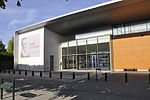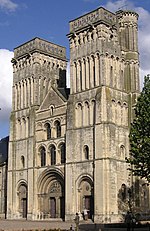Siege of Caen (1417)
1410s in France1417 in EnglandBattle stubsCaenConflicts in 1417 ... and 8 more
Henry V of EnglandHundred Years' War, 1415–1453Massacres committed by EnglandMassacres of menSieges involving EnglandSieges involving FranceSieges of the Hundred Years' WarViolence against men in Europe

The siege of Caen took place during the Hundred Years War when English forces under King Henry V laid siege to and captured Caen in Normandy from its French defenders.
Excerpt from the Wikipedia article Siege of Caen (1417) (License: CC BY-SA 3.0, Authors, Images).Siege of Caen (1417)
Promenade du Fort, Caen
Geographical coordinates (GPS) Address Nearby Places Show on map
Geographical coordinates (GPS)
| Latitude | Longitude |
|---|---|
| N 49.18 ° | E -0.37 ° |
Address
Promenade du Fort
14000 Caen
Normandy, France
Open on Google Maps











